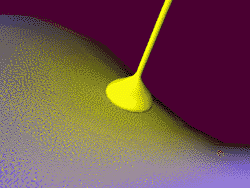![[the epicenter]](../../../../banner.gif)


VRML Living Cell

Age Range: 12-Adult
Platform: Any computer supporting web browser and VRML plug-in. For a free
VRML plug-in, click here
Medium: Internet
Cost: $39.50 (click here
for free demos and visualizations). Teachers may be eligible for a free
evaluation version.
Company: Faculty of
electrical engineering and center for scientific visualization AMNIM
Email: Dr. Tomaz Amon, Director of
AMNIM
Description:
VRML Living Cell is a collection of virtual reality worlds describing
animal and plant cells. You enter into the cell and move in its virtual
space anywhere you like discovering its structures and functions. The new
VRML technique enables that the contents of the full CD ROM becomes much
smaller in file size and can be thus easily downloaded through the web -
you do not need CD ROM medium any more.
Major topics are:
Cell Structure and Fundamental Processes
- Structures of animal and plant cells
- Ingestion of food particles (endocytosis)
- Nucleus, endoplasmic reticulum and Golgi apparatus are involved in
protein synthesis
- Protein synthesis mechanism, polysomes
Cell Membrane Permeability
- Thermal energy drives molecules to move around
- Lipid bilayer is almost impermeable for hydrophilic molecules
- Pushing molecules against the concentration gradient requires energy.
- Introduction of membrane channels
- How membrane channels work
Energy conversion in the cell
- Energy conversion play
- Evolution of mitochondria and chloroplasts
- Heterotrophs - energy conversion of food
- Mitochondrion structure
- Overview of the food energy conversion
- Respiratory chain
- Respiratory energy diagram
- Autothrophs - energy conversion of light
- Chloroplast structure
- Overview of the photosynthesis
- Photosynthesis in the tylakoid membrane
- Energy diagram
- ATP synthase
Mechanism of Muscle Contraction
- Dive into the muscle structure
- Action of motor proteins
- Sliding of filaments
- Sarcomere
- Myofibril
- Whole muscle
Cell Division (Mitosis, Meiosis)
Mitosis
- Crucial Events in Mitosis
- Duplication of genetic material, Division of centrosomes, Condensing
of chromosomes
- Nuclear Membrane decondenses
- Mitotic spindle provides the mechanical framework for the dislocation
of chromosomes
- Structure of the microtubules in the mitotic spindle
- Motor proteins enable moving of the chromosomes
- Chromosomes travel apart
- Actin filaments help to cleave the cell membrane
- Decondensing of chromosomes
- Nuclear membrane condenses
- Mitotic Phases : PROPHASE, PROMETAPHASE, METAPHASE, ANAPHASE, TELOPHASE,
CYTOKINESIS
Meiosis
- Haploid and diploid cells in the life cycle of higher eucatyotes
- Haploid and diploid cells in the life cycle of some lower eucaryotes
- Meiosis compared to mitosis
For free visualizations and further information, click here

![[Science Education index]](../../../gifs/gosubjects.gif)



We hope you found what you needed on this page. If you have
any questions or comments, please contact me.

Howard J. Bender, Ph.D.
President
The Education Process Improvement Center, Inc.
P.O. Box 186
Riverdale, Maryland 20738
hjbender@epicent.com
![[the epicenter]](../../../../banner.gif)
![[the epicenter]](../../../../banner.gif)

![]()

![]()